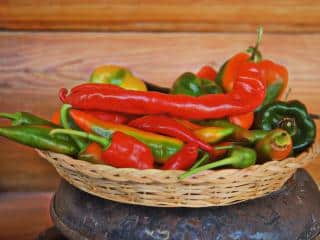

Bell pepper, or Capsicum annuum, belongs to the Solanaceae or nightshade family. This fruit, well integrated into our cooking, has many different uses and benefits for health and beauty!
It is native to Central America and is part of the pepper family.
Chili and bell pepper are fruits of the same plant, which is why sometimes bell pepper is also known under the name “mild chili”.
There are 3 main bell pepper varieties: square-shaped, rectangular or triangular.
At the beginning all are green, and they change color as they grow to become yellow, red, orange, violet or black.
They grow in temperate climates as annuals. Bell pepper is available all year round on our market places.
 Bell pepper has been cultivated for millennia. It was domesticated in Mexico 5000 years ago, as seeds found in archaeological dig sites have proven.
Bell pepper has been cultivated for millennia. It was domesticated in Mexico 5000 years ago, as seeds found in archaeological dig sites have proven.
Bell pepper arrived in the Spanish mainland during the XVth century and from there, as time passed, spread to the rest of Europe.
Bell pepper is ideal for weight loss diets! Indeed, it only has a calorie count of 20 kcal / 3.5 oz (100 g) and nonetheless makes you feel satiated quite fast. Moreover, it also contains capsaicin which has the property of slowing cell growth in fatty tissues. It is an amazing anti-cellulite.
 Bell pepper against cancer: bell pepper also has antioxidant properties. Thanks to the vitamin C that is present in great quantities, 126mg/ 3.5 oz (100 g), it slows cell ageing and staves off appearance of cancerous cells. It also protects the body from infections since it reinforces our immune system.
Bell pepper against cancer: bell pepper also has antioxidant properties. Thanks to the vitamin C that is present in great quantities, 126mg/ 3.5 oz (100 g), it slows cell ageing and staves off appearance of cancerous cells. It also protects the body from infections since it reinforces our immune system.
Bell pepper and its antioxidants neutralize free radicals and also limit cardiovascular diseases and accumulation of bad cholesterol in the arteries.
Red bell pepper is more medicinally active than is green bell pepper. Its Vitamin C contents cover 100% of our daily needs. Perfect to avoid tiredness!
Green bell pepper also contains vitamin K which is essential to the blood clotting process.
Not to be left behind, yellow bell pepper grants us vitamin B6 compounds involved in the nervous system.
Bell pepper also imparts beta-carotene, a preliminary entity that later converts to vitamin A, a vitamin that plays an essential role in our vision and also gives our skin a healthy glow.
It also has high water content (90%) which, on top of being refreshing, makes bell pepper a good diuretic. It helps avoid water retention.
 As for the digestive tract, bell pepper has stomachic activity. Fibers combined with water care for your stomach and gastric tissues.
As for the digestive tract, bell pepper has stomachic activity. Fibers combined with water care for your stomach and gastric tissues.
Bell pepper ensures satisfactory intestinal transit, reduces flatulence and eliminates intestinal parasites. Bell pepper is recommended in case of digestive disorders or gastric ulcers.
Bell pepper seems to also enhance learning capabilities and stimulates memory. Indeed, it is a source of luteolin, which curbs brain inflammations and prevents cell degeneration.
Bell pepper also presents antiseptic, stimulating and decongestant properties.
Even though it is biologically a fruit, bell pepper is cooked as if it were a vegetable.
When raw, they aren’t so easy to digest, and can cause intestinal unrest and irritate fragile bowels. Best is to eat them cooked without their skin.
A thousand and one ways to savor bell pepper! A few savory ideas:
When cooked, bell pepper will provide you with essential minerals and trace elements that are a boon to the body.
The bell pepper plant can grow up to 16 or 20 inches (40 to 50 cm) tall.
Harvested over the summer, 5-6 months after the sowing, bell peppers appreciate temperatures higher than 20 °C and require regular watering. Avoid wetting the leaves.
To care for your plants, fermented stinging nettle tea is a very good natural fertilizer.
Bell pepper fruits are harvested 5-6 months after sowing. Their color depends on the ripeness: if the green ones have just reached their mature size and just started ripening, the red ones on the other hand are fully ripe.
Great for health, bell pepper is also healthy for your hair, your skin.
A natural hair mask: blend a green bell pepper together with 2 tablespoons olive oil. Spread the hair mask on your hair for 30 minutes and rinse. It will speed their growth.
Face mask for acne skin: blend one bell pepper and one cucumber together. Add 2 table spoons olive oil. Apply on face, avoid spreading too near the eyes. Let it work for 20 minutes and then rinse off.
Choosing and keeping bell pepper
Choose your bell peppers to be firm, smooth, shiny and with the peduncle firmly attached.
It keeps for up to 8 days in the vegetable compartment of your refrigerator. It also keeps well at room temperature.
Tip to easily peel your bell peppers: Heat them up in your oven until they start swelling. Wrap them up then with wet paper towels, and the bell pepper skin will just stick to the paper.